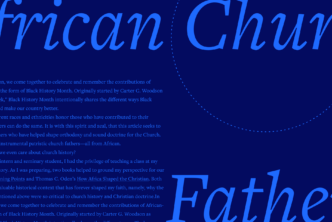The Bible doesn’t command Christians to follow an annual cycle of religious observances. And as best we can tell from the historical record, in the decades immediately following Jesus’s ascension into heaven, they didn’t. Yet, within a few centuries those early Christians were observing an organized rotation of festivals and seasons. And ever since, that churchly calendar has shaped the religious practices of untold millions of believers.
Why is this the case—why do so many Christians, for example, celebrate Lent?
How did the Christian calendar come to be?
For those first Christians, who clung tenaciously to the angels’ word that the Lord would return in like manner (Acts 1:11), the focus was not on any annual celebrations. Rather, it was on the weekly observance of the Lord’s Day—Sunday. This was the first day of the week, the day on which God had created the heavens and the earth (Gen 1:1–5). It was also the day of God’s new creation, the day on which Jesus rose from the dead. It’s not a coincidence that all four Gospel writers make note of that fact (Matt 28:1; Mark 16:2; Luke 24:1; John 20:1). Everything revolved around this weekly observance as those Christians heeded Jesus’s promise that he would be with them always (Matt 28:20). And what better way could they be certain that he was keeping that promise than by gathering together as the body of Christ each Lord’s Day? That’s where they heard his life-giving Word and received Jesus himself as he came to them in the breaking of bread (Luke 24:35; Acts 2:42; 20:7).
But as the years turned into decades, and the decades began to add up, it was probably inevitable that the church would adopt a longer view. Building on the Old Testament practice of annual celebrations—think Passover and Day of Atonement—the church turned to an annual observance of the significant events in the life of Christ as a way teaching the faith. Dedicating time each year to focus on such events as Jesus’s baptism, temptation in the wilderness, transfiguration, or ascension can help believers remember to bring them up and consider their significance.
This move toward a series of annual celebrations evolved slowly. While it may have started earlier, we have clear indications that by the end of the second century some churches were observing an annual celebration of Jesus’s death and resurrection. A regular observance of his birth developed much more slowly, not really becoming an established practice until the mid-fourth century.
When and how did Lent emerge as a distinct season?
As for Lent, the historical details are not only few but sometimes conflicting. For a long time, scholars believed that Lent developed in relation to Easter. If the resurrection of Jesus was the ultimate celebration of victory, then it made sense that the days preceding it should be treated with great solemnity. A hallmark of that solemnity was fasting, a sign of forsaking the pleasures of this world. Gradually, the theory goes, the number of days of fasting was extended—first to a week, then to three. Eventually Lent became a forty-day period of preparation before the great celebration of Easter.
In the last century, this theory has been challenged by church historians, or at least refined. There is evidence, for example, that long before the Western church, centered in Rome, had settled on a forty-day Lent, there already existed a forty-day observance in Egypt. Rather than being connected to Easter, however, this observance occurred in the days after the Eastern church’s celebration of the baptism of Jesus. You will remember how the Gospel writers report that following Jesus’ baptism the Spirit led him into the wilderness for 40 days of temptation (Matt 4:1–11; Mark 1:12–13; Luke 4:1–13). The baptism of Jesus was typically observed by the Eastern church on January 6. The subsequent forty days served as a time of intense instruction for the church’s “catechumens,” those hearers of the Word who were preparing to be baptized. As the theory goes, this period of baptismal preparation was eventually transferred a month or so later. In its new location it now served as a time of preparation for the baptism of catechumens at Easter.
Are you confused yet? As I indicated, the historical record is sparse and even conflicted, with different practices sprouting up at various times and places. What’s more, the catechetical emphasis that typically characterized the early observance of Lent would eventually change, as you will read below. At this point, however, we must explore the relationship of Lent to baptism in order to get a better picture of the earliest practice.
The connection to baptism
As the annual celebration of Jesus’s resurrection gained a foothold, a central feature of that observance was the baptism of new Christians. Baptism, after all, is a participation in the death and resurrection of Jesus (Rom 6:3–4). What better time could there be to baptize new Christians than on the same occasion when the whole church commemorates the Lord’s death and resurrection?
So how did Lent come to be associated with baptism and Easter? As Christianity spread among the Gentile population, a lengthy period of instruction came to precede baptism. There was much for these new believers to learn. Unlike Jewish converts to Christianity, Gentile converts started from scratch. They didn’t know the creation and Exodus accounts. And the stories of all the major figures of the Old Testament—Abraham, Moses, David, Elijah—were alien to them. Their time of instruction was lengthy, often up to three years as they attended the preaching of God’s Word each Sunday. Once a group of catechumens was considered ready for baptism, they were enrolled in a final period of intense instruction—forty days—that occurred during the weeks before Easter. The whole congregation became involved as they joined with these catechumens through their prayers and support. This intensive process reached its zenith in the fourth and fifth centuries. This was the very time when the church year reached its height of development.
Over time, this period of preparation would morph into something different. After several centuries of rapid expansion following the legalization of Christianity under emperor Constantine (AD 313), most everyone in the Western world was baptized. Since the need for a final, Lenten push toward baptism was no longer essential, a catechetically oriented season such as Lent began to lose its significance. That did not mean, however, that the season would be abandoned.
The relationship between Lent and contrition
Other forces were also at work in those early centuries of the church. In addition to newly minted Christians whose entrance into the church was ushered in by the forty-day Lenten preparation, there were others who were in need of re-admittance into the church. These were the penitents, those who through some grievous sin had been placed under church discipline. They were, in effect, banned from the congregation and not permitted to join fellow believers in any churchly activity. The church chose to use this same forty-day period for these penitents to prepare for their reconciliation. Once complete, they could again participate fully with the whole church.
For these penitents, their Lenten observance, while to some degree catechetical, was much more focused on cultivating a spirit of repentance. As the countdown for the forty-days of Lent was ironed out, the first day eventually landed on a Wednesday (see below). This day, known as Ash Wednesday, became distinguished by placing ashes on the heads of the penitents as a sign of mortality and contrition. Gradually, all Christians began to join in this practice as the Lenten season took on an increasingly penitential flavor. As adult baptisms began to decrease, the catechetical emphasis also receded. By the beginning of the Middle Ages, the penitential character of Lent had taken firm hold. In time, this emphasis would be linked to an intense focus on the suffering and death of Jesus. The passion accounts in the four Gospels, or a combination of all four into one account, served as the primary texts for contemplation during the season.
As adult baptisms began to decrease, the catechetical emphasis also receded. By the beginning of the Middle Ages, the penitential character of Lent had taken firm hold.
Why are there 40 days in Lent?
Because no one was keeping historical records in the early centuries, there is a considerable lack of detail regarding how the length of the Lenten season was determined. As mentioned above, the observance may have only lasted a few weeks in the earliest times. But soon enough the number forty became a defining characteristic of Lent. That number, of course, is rich in meaning, with the account of Jesus’s forty-day temptation in the wilderness serving as the template. Just as the Lord spent forty days intently focused on the Word of God as he resisted temptation, so would the church use this season to guide Christians in learning from Jesus how to resist temptation. Other occurrences of the number forty in the Scriptures also add depth to the season: Elijah’s forty days of fasting while on the run (1 Kgs 19:8); forty years of wandering in the wilderness by the children of Israel (Exod 16:35); etc.
There are, however, some quirks in how the forty days have been counted. Because of various developments, Sundays came to be omitted from the count. The reason was because Sunday—the Lord’s Day—was never considered a day for fasting (see below). Because six weeks of only six days yields a total of thirty-six, four days were tacked on at the beginning of the season in order to reach the forty-day count. It was thus around the seventh century that Ash Wednesday was established as the first day in Lent in the Western church. This, it turns out, was also the time when the season moved toward an exclusively penitential focus.
How does Ash Wednesday shape the season?
In the Old Testament, ashes figure prominently as a sign of contrition, penitence, and mourning (Esth 4:1; Job 2:8; 42:1; Isa 58:5; Jer 6:26; Lam 3:16; Ezek 27:30; Dan 9:3; Jonah 3:6). The example of Jonah is familiar to many and is most instructive. After hearing the preaching of Jonah, who proclaimed that God’s judgment was at hand, the king of Nineveh himself exchanged his royal robes for itchy sackcloth, and he sat in ashes. Aware of God’s judgment, ashes served as a reminder that apart from God, mortal man is nothing but dust of the ground. That’s exactly what God told Adam after the fall into sin. He had been formed from the dust of the ground, and one day it was to the ground that he would return (Gen 3:19).
As the penitential nature of the Lenten season took hold, the imposition of ashes became a physical reminder of our mortality. With the ashes typically came the words, “Remember that you are dust, and to dust you shall return.” The ashes, however, were not randomly applied; they are fashioned in the shape of the cross on the forehead. It was also on the forehead, you see, where the church traditionally traced the cross at baptism. While the theme of mortality is powerfully symbolized by the ashes, a more significant picture shines through. That ashen cross indicates that this sinner is marked with the sign of our redemption, the cross of Jesus.
At the time of the Reformation, many churches that broke away from the Roman Catholic Church dispensed with the imposition of ashes. In more recent times, however, the practice has reemerged among those same churches. Perhaps you’ve even seen Christians show up at work on Ash Wednesday with the ashen cross on their foreheads.
What is unique about the last week of Lent?
Some of the most significant observances in Lent occur during its final week, which is called Holy Week. During this week, the church observes specific events that occurred in the days leading up to Jesus’s crucifixion:
- On the Sunday prior to Easter, the church observes the Lord’s triumphal entry into Jerusalem.
- On Thursday, it’s to the upper room where Jesus joined his disciples for their final Passover together—and where he instituted Holy Communion. The day is often called Maundy Thursday. That rather uncommon name comes from the Latin mandatum, which means “commandment.” It was drawn from Jesus’s words on that night: “A new commandment I give to you” (John 13:34).
- On Friday it’s to the cross, where the salvation of mankind was procured. Though it goes by many names, it is best known as Good Friday. While the word good hardly seems fitting, Christians have always understood the ultimate good that God accomplished on that day as the sinless Son of God gave his life for the world.
Over the centuries, a rich feast of liturgical texts developed for Good Friday that are still used in many places. These include the Reproaches, a series of Old Testament texts that are spoken by Jesus himself as an indictment against his people. Each reproach is followed by an intense prayer of penitence for Jesus to have mercy and save us. Also on this day the entire account of Jesus’s suffering and death as told by the evangelist John is read (John 18–19). In fact, the practice in some churches is to read the full passion account from each of the Gospels during Holy Week. It’s difficult to think of anything more impactful than to be immersed in all the details of what is unquestionably the most significant part of the Gospel accounts. Why else would each of the four Gospel writers devote two whole chapters to report on events that covered less than a day in Jesus’s ministry? Clearly, the suffering and death of our Lord was central to their proclamation!
What are some unique customs of the season?
While the placing of ashes on the forehead is perhaps the most recognizable custom of the season, there are others. The intensified devotion of the season of Lent, for example, is often characterized by three disciplines: almsgiving, prayer, and fasting. These disciplines draw inspiration from Jesus’s teaching in the Sermon on the Mount. For centuries, a portion of that sermon was read as the season was newly launched each year on Ash Wednesday. “When you give to the needy,” Jesus says, “don’t be like the hypocrites” (Matt 6:1–18). The same goes when we pray and fast. Our righteousness is not one of outward show, but in humbleness of heart, which the Father alone can see.
Among these traditional Lenten disciplines, there is little question regarding the second of the three: prayer. Of course Christians are going to pray! And most Christians agree that it is good to give to those in need. The practice of fasting, however, is not as universally practiced. While the expectation to fast exists in some Christian traditions, there is resistance in others, often out of a fear that the practice might lead to works righteousness. But even if the practice has been abused in the past, that does not negate the fact that intentional fasting can be fine training. Fasting can be a helpful reminder that “man shall not live by bread alone, but by every word that comes from the mouth of God” (Matt 4:4).
Another custom of the Lenten season is the silencing of the word “alleluia” from the church’s worship. While that exuberant Hebrew cry, “Praise the Lord,” ever resounds before the heavenly throne, the subdued nature of Lent invites a temporary muting of that praise. After forty days of holding back, the resounding alleluias on Easter morning signal that the Lenten fast has clearly ended.
But do we really need to tie ourselves to a calendar in order to observe all of this?
We don’t need the traditional church calendar to fast and pray. But this brings us back to the question we considered at the beginning: What benefit is there in following the church year?
Think of it this way: each of the major seasons of the year—Advent, Christmas, Epiphany, Lent, and Easter—has its own character. As we make our way through each of these seasons, we are surrounded by a host of biblical texts, prayers, and hymns that work together to shape our understanding of the merciful work of God on our behalf. While each season has various themes at play, there is usually one that is more prominent that the rest.
Consider the season of Advent, which is all about expectation. Yes, there are overtones of penitence as the church is called to be ready for the Lord’s final return. But above all else, this is the time to join with the ancient Israelites who waited centuries for the Lord to send his promised Son. Nothing encapsulates the season better than the opening line of Charles Wesley’s hymn, “Come, Thou Long-Expected Jesus.”
Other seasons bring other emphases. Christmas is the celebration of peace on earth. Epiphany invites us to contemplate the incomprehensible revelation that this man from Nazareth is truly God. During Easter we join in the ultimate celebration that death has been swallowed up by Christ’s death, now proclaimed in the good news that he is risen from the dead.
The theme for Lent? This is the call to repentance, the acknowledgement that there is nothing good that dwells in us. Were it not for the sake of the innocent suffering and death of the Son of God, there would be no hope. Thus, Christians are invited to repent, even to lament over our sinful condition.
Is this the only time of the year when we show contrition? Of course not! Every day must be one of repentance. But in Lent it’s as though we go into the classroom where we will be taught the ins and outs of penitence. It’s our annual masterclass that schools us in the art of penitence. And so the catechetical emphasis of the early church continues. But soon enough, a mere forty days, the Lenten masterclass is ended and it’s on to the next one, the great celebration of the Lord’s resurrection.
And thus, year after year, we are reminded again and again of the wondrous deeds of our Savior who gave his life for our salvation.
Recommended books
Welcome to the Church Year: An Introduction to the Seasons of the Episcopal Church
Regular price: $10.99







